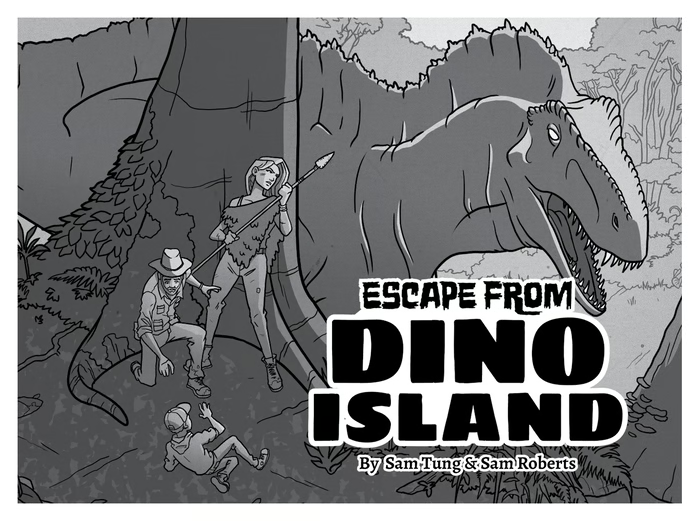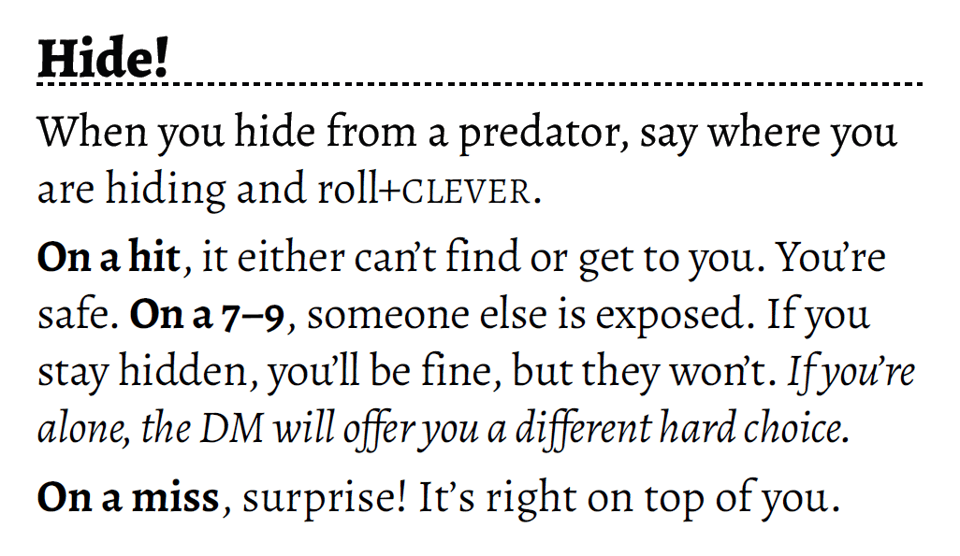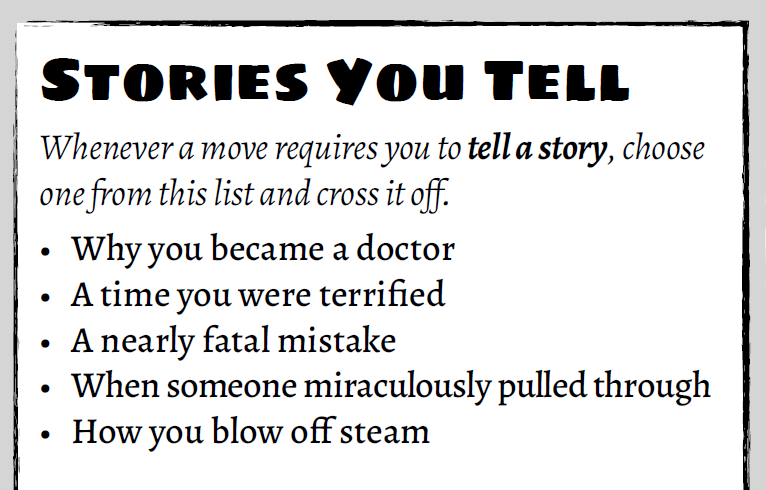Escape from Dino Island's metatriggers make sure you get in trouble

I’m taking notes on a new game,
it’s a relationship drama set during a natural disaster.1. To see how it’s done, I reread Sam Tung and Sam Robert’s great, short-form rpg Escape from Dino Island.2 Now, this game does exactly what it says on the tin: a cinematic, action-centered game about escaping an island full of dinosaurs. And what are dinosaurs if not disastrous? It seemed, and turned out, to be a great source of inspiration.
While I was reading through Dino Island's tight thirty-three pages again, I was struck by an elegant bit of design at the edge of the game's basic moves—the rules that govern most of what the players are up to. Tung and Roberts came up with a simple but effective method to push characters towards danger, while dangling safety in front of them, perfect for a story like this. It's all about about when different rules are allowed to come into play, and which characters takes the lead.
Two types of moves
For those who do not know how a Powered by the Apocalypse style move works: a move is a little procedure that gets activated as soon as someone at the table describes a situation that matches the move's trigger. For example: 'when you create a distraction to protect a friend' while playing Escape from Dino Island, you trigger the move aptly named Look Over There! which tells you to roll dice to see if you create an opening for your friend to escape.

As a smart bit of innovation, Dino Island divides its basic moves between two types: peril moves and safety moves. This is not just a categorization though. To reinforce this division, it adds what I'll call metatriggers to them. Peril moves 'come into play when you're in trouble', while safety moves 'come into play when you've got time to breathe'. While this seems obvious, it more clearly demarcates these states of play. You'll have to lose those dinosaurs before you can trigger Lay of the Land, and figure out where you're going.
But that's not where these metatriggers end. They also provide specifics on collective action, a problem point for any action-adventure game. While you're in peril, moving collectively disadvantages you, as Dino Island tells you the character 'in the worst position, or with the lowest relevant stat, rolls.' Safety is the opposite, with the character 'in the best position, or with the best stat' rolling.
An asymmetric split
Dino Island's peril-safety split produces the basic flow of the game by making trouble harder to escape and rewarding players for getting to safety eventually. In a way, it's like this game integrates the idea of success at a cost into its general structure. It then proceeds to build on these metatriggers with the moves themselves.
Peril moves trigger when you hold off, mitigate, or try to escape danger, but safety is hard won. Complete safety is only won on a 10+, which could be a chance as low as 8,34 % if your character has a low associated stat. Remember: they might be taking the lead if you try to escape as a group. A move I'd like to spotlight here, is Hide!3 On a 10+, the dinosaur can't find you: great. On a 7-9, though, while it gives up looking for you, it finds someone else instead. You're already picturing the scene, right?

Safety, on the other hand, is easily disturbed or necessarily given up. While the aforementioned Lay of the Land only gets you dinosaur trouble on a -6, it'll probably lead you back into it anyway when you try to reach the landmark you've discovered. Scavenging produces a new threat on a 7-9 and full on trouble on a -6, as will instructing another character to perform a procedure yours would be better at but can't perform because of an injury, for example. You'll have to keep rolling those 10+ to stay safe.
And then there's The Best-Laid Plans. This move activates 'when you take too long to discuss your course of action' and triggers an immediate reaction from the game master. You'll never be safe for long, and you'd best make the most of it. Before you know it, you're back in trouble again.
Character beats don't get lost
Dino Island's way of incorporating character beats and backstory into it's propulsive peril-safety feedback loop is called tell a story. Every playbook comes with it's own prompts, like 'why you became a doctor' or 'why your arch-rival is a hack'. When you trigger a safety move, you also get to elaborate on one of those prompts.

While that is already pretty cool, looking at the superstructure we've been talking about, it's especially clever that you tell the story before rolling the dice. It's not a reward for rolling well, for example, which might be expected. You'll always tell your story, even if it turns out you eventually take the wrong turn into a room full of velociraptors. This way, Dino Island can have its short-monologuing cake and eat it too. The flow of the action continues uninterrupted but will never drown out character moments.
I don't know a lot of games that have taken inspirations from Escape from Dino Island's metatriggers and structural principles. I've only encountered it in Back Again from the Broken Land4, which turns the stories to be told into a resource. Telling a so called story of doom saves you from grave danger, but you'll have to replenish the list with new stories if you want to keep doing that. I'm curious to see where other designers will take this!
That's it for now,
Hendrik ten Napel
Yes, I saw both Twister and Twisters last month, what's it to you? ↩
Escape from Dino Island, by Sam Tung & Sam Roberts. ↩
Each peril move's name is an exclamation, which is just such a fun way to emphasize the tone of the game. ↩
Back Again from the Broken Land, by Alexi & Leah Sargeant. ↩